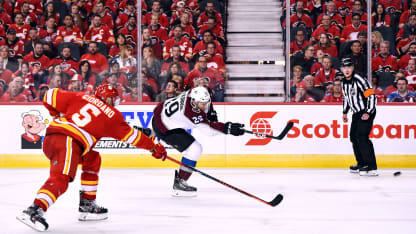The Flames were tied for the second-most goals at the conclusion of the main campaign with 289 and averaged 32.4 shots per game, but they were outshot in the final four games of the series (all Avalanche wins) and only mustered more than two goals in a contest once: a 4-0 win in the first contest.
"I liked our defending mentality through the whole series," said head coach Jared Bednar. "I thought we got much more competitive on the offensive side of things starting in Game 2, and we continued that through the series."
Calgary finished the regular season with a 53.82 shot-attempts-for percentage during full-strength play, fifth highest in the NHL, but had a hard time generating close to those numbers against Colorado. The Western Conference regular-season champions only managed a 42.09-percentage in Round 1, second worst in the NHL entering Monday night's games.
Colorado presently has the fourth highest mark in the playoffs at 54.94 percent, the highest mark among teams that have presently advanced to Round 2.
"We're being aggressive," said Nathan MacKinnon. "Guys are involved and having a shooting mentality."
The Carolina Hurricanes (60.15) and Nashville Predators (56.44) both have better numbers than the Avs, but each club faces a possible elimination game on Monday. The Pittsburgh Penguins' are third on the list at 54.75 percent, but they were swept in four games by the New York Islanders in their opening-round set.
"We're encouraging our guys to get in scoring areas, to get inside the dots, don't overpass," Bednar said. "[The Flames] do a really good job packing it in in front of their net. Their sticks are real active and good, and they track back hard in the middle of the ice so you don't want to overpass it when you get the opportunity to get inside the dots and get in the scoring area. Whether we get their first screen or not, you got to try to use their team as a screen sometimes too."
The Avalanche outscored the Flames 17-11 in the series and averaged 41 shots per game, currently the highest during the NHL postseason. Colorado outshot Calgary 56-29 in its 6-2 victory in Game 3 and then had a 52-37 edge in a 3-2 overtime victory in Game 4. The 56 shots in Game 3 were the most ever in a regulation playoff contest in franchise history, and the 108 combined pucks fired on net over the two contests were the most in a two-game span during the postseason since the team entered the NHL in 1979.
In the Avs' 3-2 overtime win in Game 2, they only had a 39-37 edge in shots on goal but had 23 more total attempts than the Flames (84-61). It was the start of a three-game stretch that had Colorado hold 57.91 percent of the total 5-on-5 shots attempted.
"We talked about it after Game 1, we got shutout in Calgary, and we talked about what we can do a little better," Rantanen said. "Probably get more shots and that's what we've been doing the last couple games. A lot of shots are from rebounds too."
The Avalanche's attack mentality was two-fold: firing more shots on Flames netminder Mike Smith and driving to the front of the goal to try and knock in any possible caromed pucks. That net-front presence was how J.T. Compher scored late to force overtime in Game 2 (rebound) and then how Compher (rebound) and Rantanen (deflection) registered markers to erase a two-goal deficit in the third period for Colorado of Game 4.



















